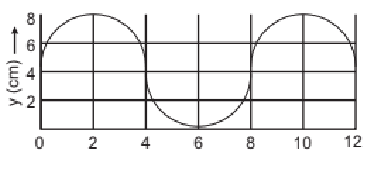UNIT NO.9
Waves and Energy
(Solved Exercise)
9.2 Define the following.
1. Wave
Waves are the patterns of vibratory motion that transfer energy from one place to another without transferring matter.
2. Electromagnetic Wave
Waves which don’t require any material medium to travel through are called electromagnetic waves.
3. Wavelength
Wavelength is the distance between two consecutive compressions or rarefactions.
4. Frequency
Frequency is the number of cycles or waves of a vibrating object passing through a point in one second.
5. Amplitude
The maximum displacement of the vibrating objects from its mean position is called its amplitude.
6. Time Period
The time during which a body completes one wave cycle is called the time period. It is represented by T.
9.3 Answer the following questions.
1. How can you differentiate between longitudinal and transverse waves?
Transverse Waves
The wave in which particles of the medium vibrate perpendicular to the direction of waves is called transverse wave. Transverse waves can only be produced in solids or on the surface of a liquid. Example : Waves produced in a stretched string.
Longitudinal Waves
The waves in which particles of the medium vibrate parallel to the direction of motion of the waves
are called longitudinal waves. Example : Sound waves
2. Why we consider sound waves as longitudinal waves?
Sound waves are considered longitudinal waves because the particles of the medium vibrate parallel to the direction of wave propagation. This means areas of compression and rarefaction are formed as the wave moves through the medium.
3. Give examples of sounds that differ in (1) loudness (2) pitch ?
Loudness:
A whisper vs. a shout
A purring cat vs. a barking dog
A soft breeze vs. a hurricane
Pitch:
A baby’s cry vs. a man’s voice
A bird’s chirp vs. a lion’s roar
The high beep of an alarm clock vs. the low hum of a refrigerator
4. What is meant by audible sound?
The sounds that we can hear are called audible sounds.
5. What is the audible frequency range of human?
Audible frequency range of human is 20 Hz to 20000 Hz (20 kHz).
6. What is the audible frequency range of a bat?
Audible frequency range of a bat is 2000 Hz to 120 kHz.
7. Which type of sounds are used in some emergency?
In emergencies, loud, high-pitched, and repetitive sounds like sirens, alarms, beeping, and horns are used to alert people of danger and prompt immediate action.
9.4. Constructed Response Questions
1. State some important uses of sounds.
Answer:
1. Communication: Sounds help us talk and understand each other. We use words and voices to share information and express feelings.
2. Warning Signals: Sounds like alarms and sirens alert us to danger. They keep us safe by letting us know when something is wrong.
3. Entertainment: We enjoy music, movies, and games because of sounds. They make these activities fun and interesting.
4. Nature Awareness: Birds chirping, water flowing, and wind rustling leaves are sounds in nature. They help us connect with the environment and understand the world around us.
2. How can you prove that animals or birds also communicate with one another?
Answer:
Observation: Scientists have observed animals making specific sounds in different situations, such as warning calls or mating calls.
Response: Animals often react to these sounds by changing their behavior. For example, they may gather in a group or flee from a potential threat.
Consistency: Certain sounds consistently convey specific messages among animals, showing a pattern of communication.
Research: Studies have used technology to record and analyze animal sounds, providing evidence of structured communication systems in various species.
3. Why we cannot hear the whistle of a bat?
Answer:
The whistle of a bat is at a frequency too high for human ears to detect. Bats use ultrasonic sounds, which means the waves are beyond the range of human hearing, typically above 20,000 Hertz. Since our ears are not sensitive to such high frequencies, we cannot hear the whistle of a bat. Bats use these ultrasonic sounds for echolocation, helping them navigate and find prey in the dark.
4. Why you can hear very weak sound easily in the night but not during the day?
Answer:
At night, the environment is generally quieter because there is less human activity and traffic. During the day, there are many sounds from various sources like traffic, people talking, and machines running. Additionally, during the night, the air is cooler and more stable, leading to less interference and distortion of sound waves. This allows weak sounds to travel more effectively and be heard more easily in the quiet nighttime environment.
5. The given wave is transverse in nature.
Identify and write the names for A, B, X and Y

Answer:
A: Trough
B: Crest
X: Amplitude
Y: Wavelength
6. For a transverse wave as shown in the Figure, Answer the following questions:

a. What is the amplitude of the wave?
Answer: 4cm
b. What is the wavelength of the wave?
Answer: 8cm